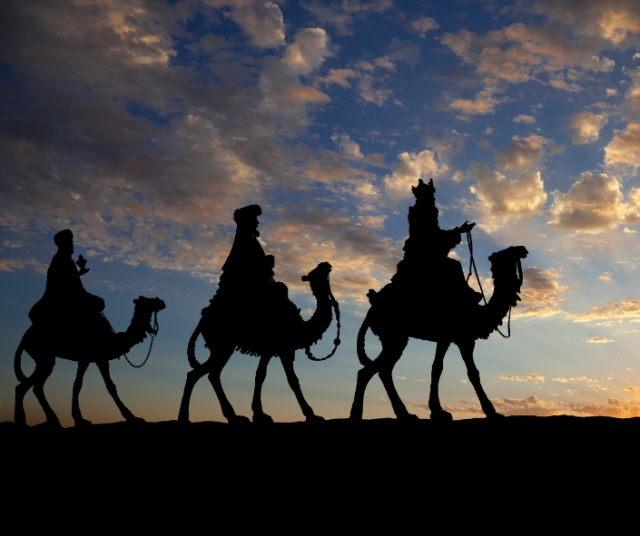The arrival of January 6 marks one of the most anticipated festivities in Spain: the Three Wise Men celebration. This day, also known as Epiphany, is celebrated with enthusiasm and joy throughout the country, becoming a magical experience for both children and adults.
Historical Origins: The Epiphany and the Three Wise Men
The celebration of the Three Wise Men in Spain finds its roots in the ancient biblical stories that narrate the Epiphany, a central event in Christian tradition. The word "Epiphany" derives from Greek and means "manifestation" or "appearance." In this context, Epiphany commemorates the revelation of Jesus Christ as the Son of God to the world.
The biblical story that inspires the festival is found in the Gospel of Matthew, which describes the visit of three wise men from the East, known as the Three Wise Men or the Wise Men, to the birthplace of Jesus. These wise men, whose traditional names are Melchior, Gaspar and Baltasar, followed the star of Bethlehem, guided by the belief that this heavenly light would lead them to the newborn Messiah.
The offering of gifts by the Three Wise Men, symbolized by gold, frankincense and myrrh, is a fundamental part of the biblical story. The gold represented the royalty of Jesus, the incense his divinity and the myrrh his humanity and future sacrifice. This gesture of generosity and tribute to the baby Jesus has permeated the celebration of the Three Wise Men throughout the Christian world.
The Three Kings Parade: A Parade of Magic through the Streets
One of the most notable events during the Three Wise Men celebration in Spain is the traditional Three Kings Parade. This parade, which takes place on the afternoon of January 5, runs through the main streets of Spanish cities and towns. The Three Wise Men, accompanied by their pages and other mythical characters, throw candy and small gifts to the crowd as people gather to enjoy the spectacle.
The floats, decorated with bright lights and Christmas motifs, transport the Three Wise Men in a parade full of music, color and joy. This event is not only a sight for the eyes, but also reflects the cultural importance given to the arrival of the Three Wise Men and the tradition of exchanging gifts.
The Magic Night of January 5: Family Traditions
The night of January 5 is awaited with great anticipation, especially by the little ones. According to tradition, this is the night when the Three Wise Men visit Spanish homes to leave gifts for children who have been good during the year. In many homes, a shoe or boot is placed by the window or door, and children go to bed with the excitement of waking up the next day to find gifts.
Three Kings Eve is also a time to enjoy a special family dinner. Many people prepare traditional dishes such as roscón de reyes, a donut-shaped sweet decorated with candied fruits and sugar. This dessert, often filled with cream or cream, is served as the perfect culmination to a festive dinner.
The Roscón de Reyes: Sweet Symbol of Celebration
The roscón de reyes is more than a simple dessert in the Three Wise Men celebration in Spain; It is a symbol of the holiday. This delicious and decorated sweet bread has a circular shape that symbolizes the crown of the Three Wise Men. Inside the roscón, small surprises are often hidden, such as a figure representing the baby Jesus or a bean. The person who finds the figure is crowned "king" or "queen" for the day, while the one who finds the bean assumes the responsibility of paying for the roscón.
The Importance of Gifts and the Exchange of Good Wishes
Gifts play a central role in the Three Wise Men celebration in Spain. Although the tradition of exchanging gifts is related to the giving of presents by the Three Wise Men, it is also common for families and friends to give each other gifts. The choice of gifts varies, but the essence of the gesture lies in sharing good wishes and joy during this festive season.
Children, in particular, look forward to opening their gifts on January 6, discovering what the Three Wise Men have left for them. This tradition reinforces the magic of the holiday and creates lasting memories that last in the memories of the youngest.
Regional Celebrations: Cultural Diversity in the Three Wise Men Celebration
Throughout Spain, Three Wise Men celebrations take on various forms and nuances, reflecting the country's cultural richness and regional traditions. In some communities, theatrical representations of the arrival of the Three Wise Men are held, while in others, festivities include religious events and processions.
In the Andalusia region, for example, the Three Wise Men celebration often includes active community participation, with neighbors collaborating to organize events and parades. In Catalonia, the figure of "El Tió de Nadal", a wooden log that is beaten to make it "excrete" gifts, is an integral part of the festivities.
The Tradition Continues: Modern Adaptations and Cultural Significance
As time progresses, the Three Wise Men celebration has undergone modern adaptations. In some urban areas, Three Kings Parades incorporate contemporary elements, such as technological floats and special effects. However, despite the modifications, the essence of the holiday remains rooted in the cultural and family connection it represents.
The Three Wise Men celebration in Spain is not only a religious festival, but also an expression of cultural and community identity. Through the generations, this tradition has evolved and adapted, but its ability to bring people together and convey a sense of magic and hope endures.
The magic of the Three Wise Men lives in every corner of Spain, turning this festivity into a celebration that goes beyond the material, reaching the heart of the community and reaffirming the importance of unity, generosity and hope in the human spirit. .
